Making your own vegetable broth from kitchen scraps is an economical way to have delicious, no-waste vegan broth whenever you want! There’s absolutely no effort required at all! It’s a great way to reduce waste and eliminate the expense of shop-bought stock cubes or powder. You also know what’s gone into it, which can’t be said for what you buy in shops.
- A zero-waste vegan broth
- What is the difference between vegetable broth and vegetable stock?
- Vegetable broth ingredients
- Can you use the scraps from other vegetables to make broth?
- Vegetables to avoid when making broth
- Herbs and other flavourings
- Salt
- Proportions
- Mushroom broth
- Vegetable to water ratio for broth
- How to make vegetable broth from kitchen scraps
- Instructions
- Uses for your homemade vegetable broth
- How long does homemade vegetable broth last?
- How to safely store vegetable broth
- Before you go
A zero-waste vegan broth
Get into the habit of using scraps to make vegetable broth instead of whole onions and carrots, which we sometimes have no use for afterwards. It’s a pity to waste food like that. You can make perfectly good vegetable broth using the trimmings. So, unless you’re actually going to eat the boiled vegetables after making your broth, using scraps is the way to go for zero waste!
What is the difference between vegetable broth and vegetable stock?
The terms vegetable stock and vegetable broth are often used interchangeably. However, some people classify them differently.
- Stock: simmered for longer periods (typically several hours) with a higher vegetable-to-water ratio, used as a flavour base for stews, soups, etc.
- Broth: simmered for a shorter time (about an hour) with more water, resulting in a lighter flavour, often consumed as a standalone soup or for ravioli, etc.
Overall, while there may be slight differences in perception or usage, both are made by simmering vegetables in water to create flavourful liquids. For the purpose of this blog post, you can consider them one and the same thing. I use this vegetable broth recipe for all the applications mentioned above.

Vegetable broth ingredients
What vegetable scraps to use?
While you’re preparing vegetables for other dishes, set aside the peelings and trimmings of onions, carrots, celery, leek and parsley.
Onions
Keep the outer, partially dried layers of onions. You can even add the brown outside layers and the tops and bottoms – those will make a deep brown stock, which is great for making gravies and dark sauces! This is not desirable for risottos and light-coloured sauces, so I usually keep them separate.


Carrots
Before peeling carrots, wash them, and keep the peelings, tops and bottoms. Washing them will hopefully eliminate pesticides as well as any soil, etc. Only use scraps from vegetables that are in good condition. Anything with signs of mould or rotting should be thrown away without hesitation.

Celery
Every time you trim celery stalks, keep the leaves and other trimmings. Wash them and add them to the broth bag. I keep my bag at the very front of the top drawer of the freezer for easy access.
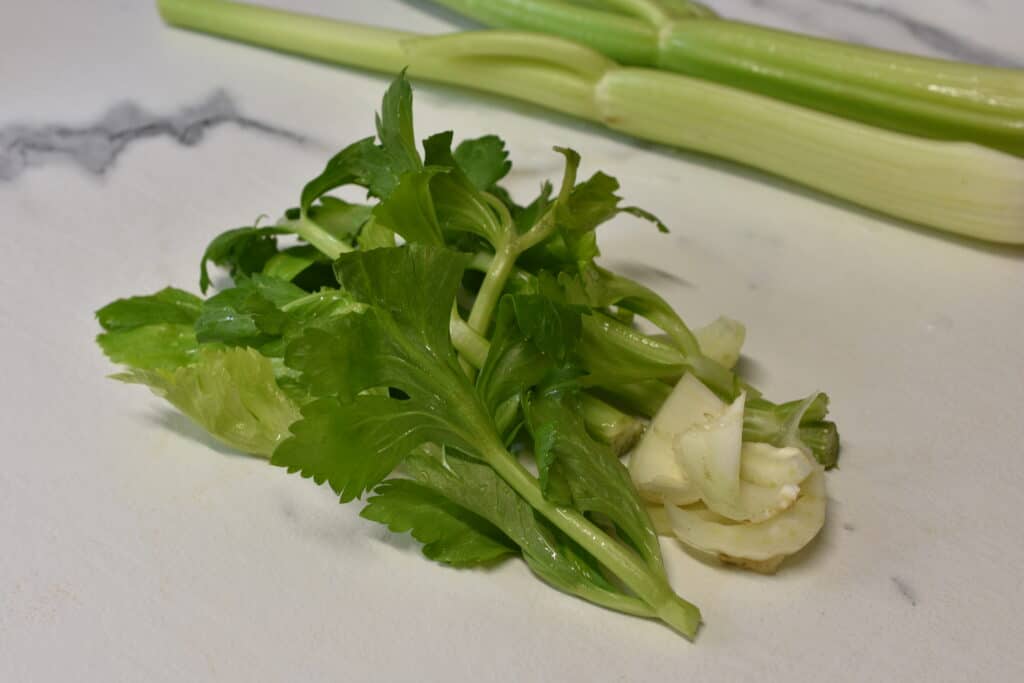
Leek
You can do the same with leek trimmings. Wash and keep any parts that are not going into a recipe.

If you do this every time you trim vegetables, you’ll soon have enough scraps to make some delicious homemade vegetable broth! I use a large freezer bag and put the scraps in the freezer immediately.

Put the bag in an easily accessible place in the freezer so that you just have to open the door, put the scraps in and close the door. Some say that you shouldn’t mix frozen and unfrozen foods, which is true. I don’t mix them – I just lay them on top and then fold the bag to separate the new trimmings from the already frozen ones. Otherwise, you could use a separate smaller bag, and once the trimmings are frozen, you can transfer them to the main bag.
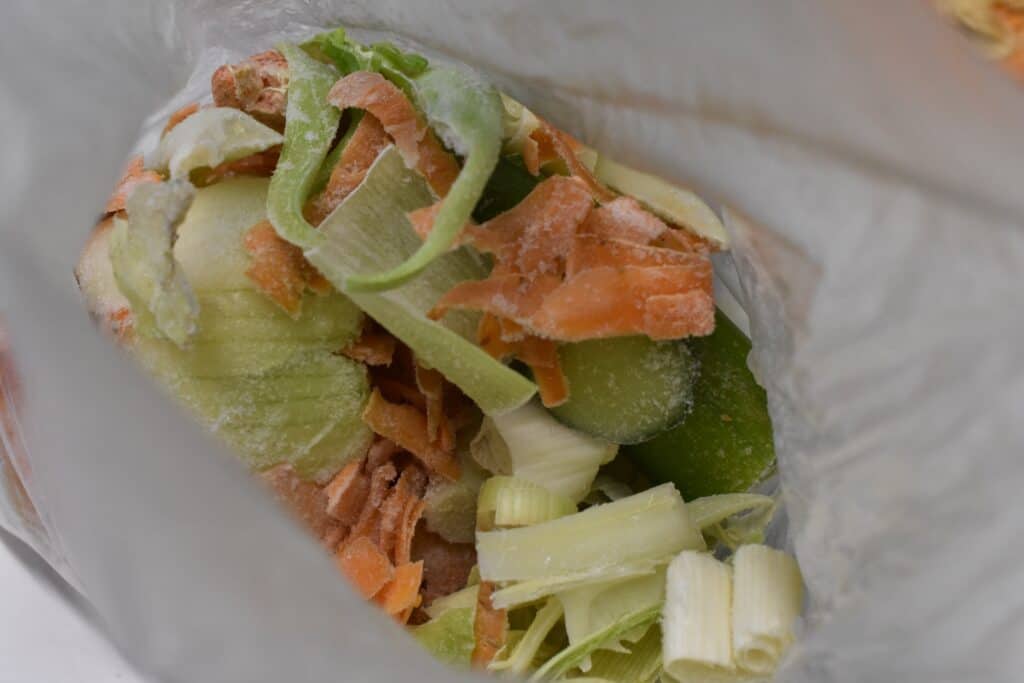
Can you use the scraps from other vegetables to make broth?
The general consensus is that BASIC vegetable broth is made with just onions, carrots and celery, with the optional addition of leek and parsley. Adding other ingredients will often result in the broth being bitter or cloudy or having a strange taste or colour.
Ingredients such as garlic, tomatoes, mushrooms and other vegetables may be added to enhance the flavour of certain dishes, but why not add them directly to the dish rather than to the broth? You may not want tomatoey broth or garlicky broth for other recipes. Imagine an asparagus soup made with tomato broth or a vegetable soup that tastes of mushrooms. Not very desirable, right?
Vegetables to avoid when making broth
Vegetables that should be avoided when making vegetable broth are:
- courgettes, because they can make the broth taste bitter
- potatoes and tomatoes will make the broth cloudy
- vegetables like peppers, aubergines, pumpkin, asparagus and artichokes will give the broth a very strange taste and colour
- Cruciferous vegetables like broccoli, cabbage, brussels sprouts, and cauliflower can make the broth bitter
- Leafy green vegetables, like spinach or erbette (perpetual spinach), will make the broth green, which is OK for green vegetable soups and very healthy too. It wouldn’t be such a good choice for carrot soup, though – orange and green make brown! Use your discretion with leafy green vegetables.
Herbs and other flavourings
The only herb I recommend putting in with the scraps is parsley: trimmings like stalks and any leftover leaves.

Some people add a bay leaf and rosemary to their broth. I don’t because they have a strong taste, and I prefer to add them to the stew or whatever it is I’m making rather than to the broth. The same applies to other herbs – it’s better to choose them for the particular dish you’re making rather than putting them in the scrap bag for broth. Once you’ve got a rosemary-flavoured broth, you’re stuck with it.
Salt
I only add salt when I am ready to use the broth in a recipe – I never add it to the broth that I’m freezing or jarring to store for later use. I think the amount of salt you add depends on what you’re going to use the broth for. Some recipes require less salt than others, so I prefer to add it as needed. I only use unrefined sea salt in all my recipes.
Proportions
When the time comes to use the vegetable broth, the proportions of onion, carrot, celery and leek scraps should be more or less equal. Having more onion than the other vegetables is perfectly fine, but the opposite should be avoided. Don’t exceed 25% of celery and leek – both have a robust flavour and will overwhelm your broth. Carrots are quite delicate in taste, so if there’s more than 25%, it shouldn’t be a problem. It’s natural to have more onions than anything else because that’s what we use most.
Mushroom broth
You could also make your own mushroom broth from mushroom stalks and any other trimmings as long as they are sound and do not show signs of mould or rot. Mushroom broth is really useful for dishes like mushroom bourguignon, mushroom Stroganoff and mushroom sauce. It’s a great base for umami gravies to accompany nut roasts and vegan Wellingtons.
Vegetable to water ratio for broth
A ratio of 1:2 of vegetables to water is a good guide for a full-flavoured broth. The general consensus is 1 part veg to 2 or 3 parts of water. The higher the vegetable-to-water ratio, the stronger the flavour. Some evaporation will occur during cooking, so if you start with 1 kg of vegetables, you can expect them to yield two litres of finished broth if you start with 2,5 – 3 litres of water. A certain amount of evaporation occurs even with a lid on the pan, so expect to find less than you put in.
How to make vegetable broth from kitchen scraps
Instructions
Tip your fresh or frozen vegetable scraps into a saucepan and add cold water.
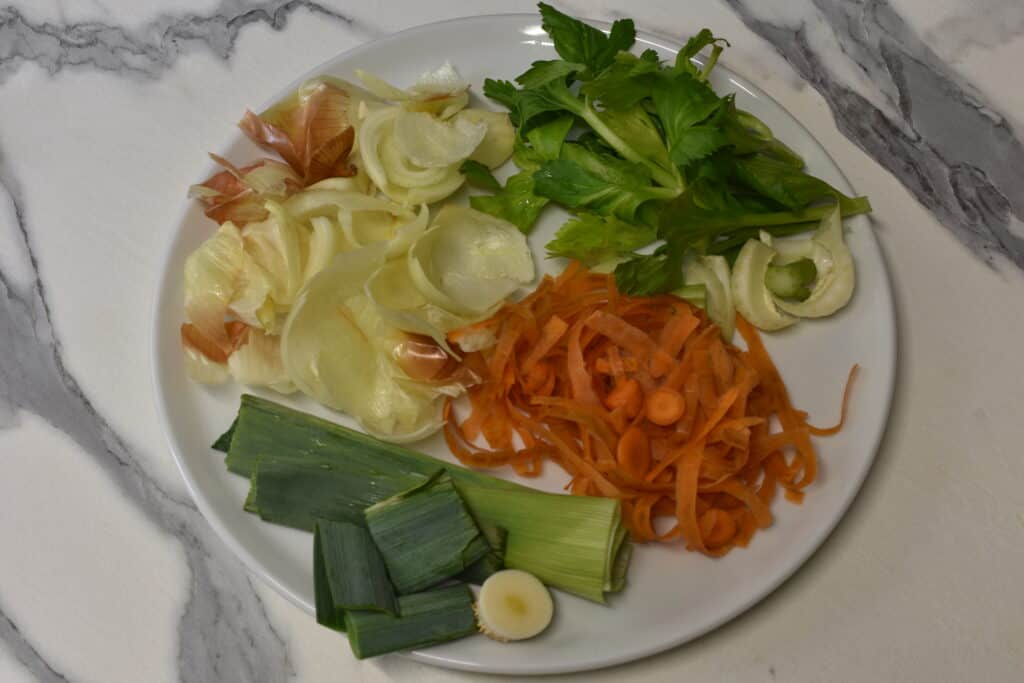

Bring it to a boil and let it simmer gently for about an hour while you’re doing other things.

Strain the broth through a sieve. Now, your clear, amber-coloured broth is ready to use or store!

Uses for your homemade vegetable broth
You can use your delicious vegetable broth made from kitchen scraps in a multitude of dishes. Broth is the base for many soups and stews. Speciality dishes like dumplings and tortellini are often cooked in broth.
You could try my canederli al radicchio e zucca hokkaido in vegetable broth or ribollita toscana, a delicious Tuscan vegetable and bean soup. Take a look at the other tempting recipes below! Homemade vegetable broth will elevate all these dishes to another level!






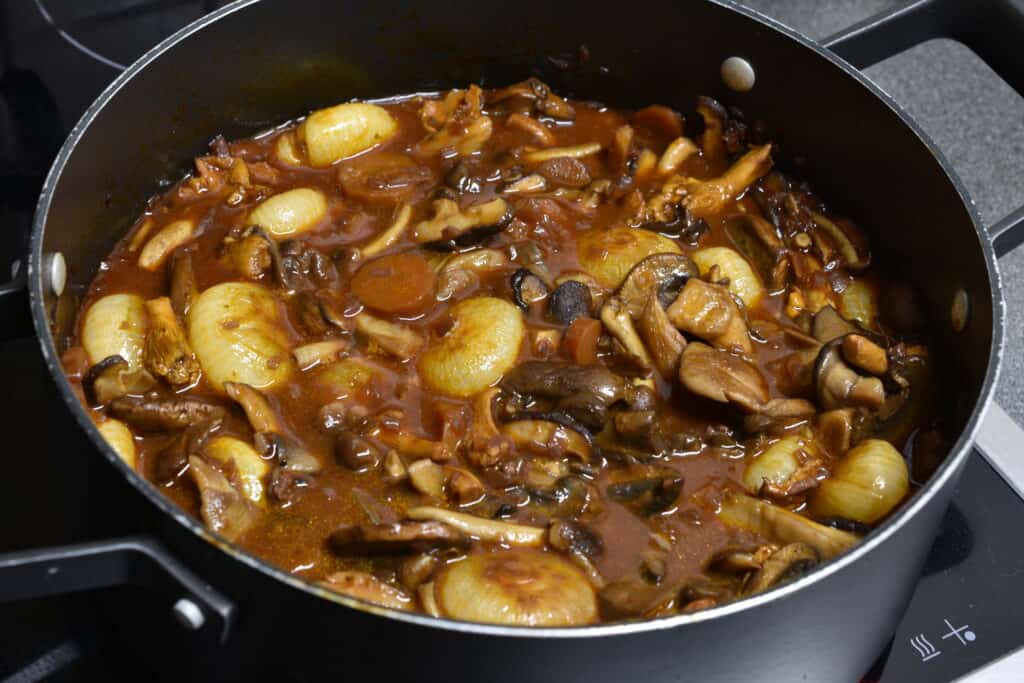
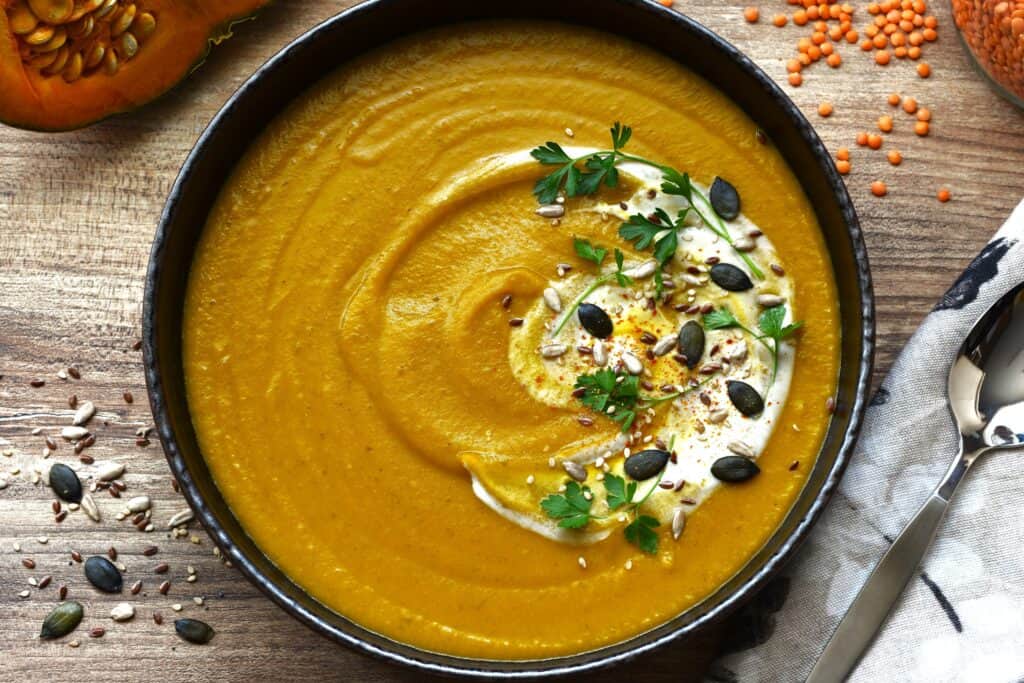
How long does homemade vegetable broth last?
How long vegetable broth will last depends on how you store it. You should never leave broth on the stovetop or on the counter at room temperature. Does vegetable broth go bad? Yes, it does. Very quickly, especially in hot weather. One of the first signs that it has gone off is when it is no longer clear and starts to become cloudy. You may also notice bubbles, which is a sign of fermentation. Changes in colour, taste or smell are also signs that it has gone off. It’s crucial to prioritize food safety, and if there’s any doubt about the freshness of vegetable broth, it’s safer to discard it rather than risk consuming it.
How to safely store vegetable broth
You can store homemade vegetable broth in 3 ways.
Storing broth In the fridge
Vegetable broth will keep for several days in the fridge. Store it in a suitable container, such as a jar or glass container with a lid.
Can you freeze vegetable broth?
Freezing is a simple and easy method to conserve your vegetable broth. You can freeze it in cubes, bags or other containers of your choice. To reheat from frozen, allow the broth to defrost at room temperature. Then, bring it to the boil and use in the same way you would use fresh vegetable broth.
Canning vegetable broth
The third method is jarring, bottling or canning. This method involves sterilising the vegetable broth using the hot water bath method. The procedure is simple, but there are several precautions that you must take. You can read my detailed step-by-step guide on home canning here. Basically, the broth is brought to a boil and then poured into pre-sterilised jars. The jars are then immersed in a pan of boiling water. The water must cover the jars for the entire boiling process, which takes 20 minutes. The jars should be allowed to cool down in the pan. As they cool, a vacuum forms in the jars and the lids click down, which means they are sealed. You can store them like this for many months.
The risk rises exponentially with home jarring, bottling and canning. You can find out all you need to know about preserving and sterilising in my post on How to make and jar tomato sauce. The procedure for jarring broth is identical to that of jarring tomato sauce.

So that’s it. It’s so easy to collect scraps, freeze them, and get them out whenever you want to make vegetable broth. It reduces waste and only takes about an hour to make – with no hands-on time involved at all. Just put the frozen scraps in a pan and let them simmer while you get on with other things!
Before you go
I hope you liked this recipe for homemade vegan broth made from leftover vegetable scraps! If you did, would you consider giving it a star rating and maybe leave a comment below? This is really useful for other readers and helps them find my blog and recipes. I also really appreciate the feedback because it helps me make my recipes more successful. Thanks for your support!
While you’re here on, maybe you’d like to take a look at some other popular recipes!


Would you like to receive my recipes as soon as I publish them? Subscribe below!







